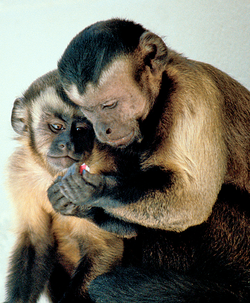User:Bob98133/Sandbox2

An exotic pet is a rare or unusual creature kept as a pet, or a creature kept as a pet which is not commonly thought of as a pet.
The definition is an evolving one; some rodents, reptiles, and amphibians have become firmly enough established in the world of animal fancy to no longer be considered exotic.[citation needed] Sometimes any unique or wild-looking pet (including common domestic animals such as the ferret and the domestic rat) is called an exotic pet. "Exotic" may also be used for a species which is non-indigenous to the owner's locale.
Many major pet stores and service providers (such as veterinary insurance carriers or online retailers) tend to classify any animal besides cats, dogs, or fish as "exotic".
Issues
[edit]Legal issues
[edit]The Convention on the International Trade in Endangered Species of Wild Flora and Fauna, or CITES, moderates the trade of some exotic pets around the world, to prevent any threats to their survival and ecological damage. Certain animals may be strictly regulated or restricted outright due to both their conservation status, as well as the possibility of the animal becoming an invasive species.
In some cases laws are circumvented by breeding the animals in captivity. The USDA issues permits for keeping and breeding certain exotic species, whether captured from the wild or bred. In the United States, for example, it is illegal to import primates for the pet trade, but a flourishing breeding industry exists, using animals descended from those brought in legally before the ban was enacted.[citation needed]
In 2003, the US Captive Wild Animal Safety Act became law and in September of 2007 the US Fish and Wildlife Service enacted rules to enforce the CWASA. The law now bans the sale or transport of big cats, which includes lions, tigers, leopards, jaguars, cougars, snow leopards, clouded leopards, cheetahs and their hybrids across state lines for the pet trade. [1]
Health
[edit]Veterinary costs for treatment of exotic animals may be significantly higher than for a more conventional pet due to the increased specialization.
Some animals are known to carry diseases that can affect humans, such as salmonellosis and rabies. Similarly, some human diseases can be dangerous for certain animals (like strep throat). Many animals have zoonotic potential. Some of the most lethal viruses, the hemorrhagic fevers, are spread through contact with exotic pets, resulting in high death rates and disabilities for those who survive. The American Veterinary Medical Association, the U.S. Department of Agriculture, the National Animal Control Association, the American Zoo and Aquarium Association and the CDC all discourage the private ownership of certain exotic animals.[2]
Husbandry
[edit]Providing appropriate environmental conditions, housing and diet for an exotic animal may be difficult for several reasons:
- insufficient information may be available on caring for such animals in captivity
- adequate housing may be difficult and/or expensive to procure or build
- it may be difficult to provide the correct environment (such as temperature or amount of sunlight)
- feeding the correct diet may be difficult or impossible
- providing the right social environment for highly social species may be impossible in a home setting
Domestication
[edit]Unlike cats and dogs, most exotic animals have not been domesticated by humans; they are still wild animals. Even if they are bred for the pet trade and raised by humans, they may be unpredictable, largely untrainable, and in some cases, dangerous, especially as full-grown adults.
Species kept as exotic pets
[edit]- Alligators
- Arctic Fox
- Wolves and wolf/dog hybrids
- Fennec foxes
- Ferrets
- Tame Silver Foxes
- Sugar Gliders
- Skunks
- Degus
- Kinkajous
- Raccoons
- Chinchillas
- Hedgehogs
- Wild cat cubs such as lions, tigers, bobcats, servals, and ocelots
- Reptiles such as snakes, tortoises, and lizards
- Arthropods like spiders, praying mantises, and scorpions
- Extremely rare birds
- Primates (see below)
Some exotics may be considered to be less "wild" than others; dingoes have been in a relationship with humans for generations and are thought to be an early breed, and the Bengal cat descends from a hybrid of wild and domestic species. Llamas and pot-bellied pigs, though still present in the wild, have been raised in captivity for centuries.[citation needed]
Primates
[edit]{{globalize}}
It has been estimated that as many as 15,000 primates are kept by private individuals as pets in the United States.[1] Nine states ban the keeping of primates, but no federal law regulates primate ownership. In 1975, the Center for Disease Control prohibited their import into the US for use as pets. The breeding industry uses descendants of animals imported before 1975. Primates of various species, including those listed as endangered, such as cottontop tamarins, Diana monkeys, lemurs and gibbons are still available for purchase in the US.
Many professionals, including veterinarians, zoologists, humane societies and others, strongly discourage the keeping of primates and monkeys as pets, as their complex emotional and social needs and other highly specialized requirements cannot be met by the average owner.[citation needed]
Although the breeding population has been largely isolated from wild primates outside the US, and may not be as likely to transmit a zoonotic disease, there is still a considerable risk: research workers have died from diseases contracted from primate research subjects.[citation needed] The risk of transmission of disease from humans to primate, such as the virus which causes human cold sores (herpes simplex virus), is possible and can be deadly.[citation needed] New zoonotic diseases continue to emerge.
References
[edit]See also
[edit]- Maryann Mott, "The Perils of Keeping Monkeys as Pets" National Geographic News September 16, 2003
